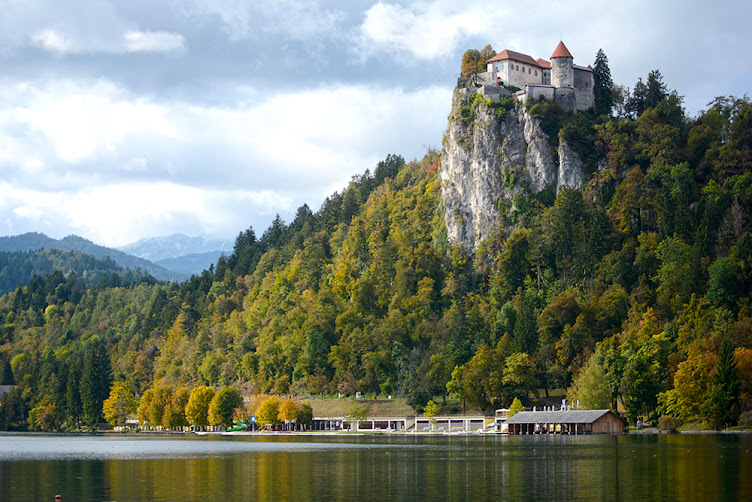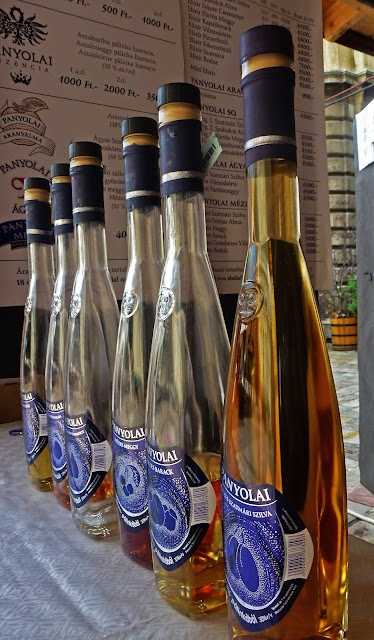You can't really run out of things to do in Budapest. no matter how hard you try- when the locals take some rest, the many embassies and cultural institutes strewn across the city will organize events such as the one seen above- Restaurant Day at the Finnish Embassy up in Buda. The walk to the embassy is already an enjoyment in the cool shade of the Buda hills, passing by the Gellert spa and many charming early 20th century houses. The building of the embassy is also worth the attention, as it was built in the typical Finnish architectural style made world famous by the works of Alvar Aalto among others. The menu of the day? Finnish salmon soup and pancakes with jam and cream.
Bled

Saturday 19 May 2012
Sunday 13 May 2012
The Water of Life
If a plant growing in our area gives some sort of fruit, rest assured that the Hungarians will take it upon themselves to make pálinka out of it. The well established stars are of course plum, apricot and pear but a thorough search will uncover wonders such as onion and paprika pálinka. For something to be called pálinka it has to comply to several guidelines (the European Union kindly made sure that nations in Central Europe will kick some dust around who can make what kind of alcohol out of which fruit and how- the final outcome is blurry, to say the least).So pálinka must be at least 37.5 degrees strong and must be made of 100% fruit, no added sugar or other colour or taste enhancing substances.Thus one of the local favourites- honey flavoured pálinka, has to be officially marketed as likőr. All this theory becomes somewhat pointless when faced with the onslaught of choice at one of the two yearly Pálinka Festivals held in the Buda castle- one in spring and one in autumn, the second tends to be bigger as manufacturers bring their new products for a first introduction and the chillier weather provides a better backdrop for intense consumption. The spring festival has such delights as a plum pálinka-maracuja juice slushy- I have a feeling that our elders would feel a tad insulted at the thought, but sadly no one asked them. As a well-versed expert I might add that you should not miss out on the Panyolai pálinkas, they have an excellent szatmári szilvapálinka (plum pálinka from the Szatmár area, one of the eight protected pálinka producing regions in Hungary) and several exciting honey-weird fruit mixtures. For those tending to be less enamoured with alcohol, the festival provides several types of rather hearty Hungarian dishes and sweets including handmade chocolate and macarons, out of all things. Also, the above mentioned slushy can come without the added spirit- but that would be missing out on half the fun, after all.
Saturday 12 May 2012
Grandma's goodies
Been away from Budapest for a bit, which got me thinking what would be the things that I'd really miss if I moved out for good. Nagyi Palacsintázója would definitely end up on the list. Translated as Grandma's Pancakes the place offers exactly that- the good old classic type of Central European thin pancake with your topping(s, it always ends up plural somehow) of choice, salty or sweet. As a plus they throw in some baked potatoes and a few basic soups-Budapest comfort food at its best. Their mainstay on Batthány square can get a bit crowded at times, which is to your advantage really, because you can spend some time thoroughly analysing the toppings list, which at first glance is almost menacing. Actually, it's just simply delicious.
Thursday 3 May 2012
A Ride into the Sunset
Hungarians have always been fond of horses and a nation of good riders- as proof, Budapest has a rather high number of equestrian statues. Though truth be said, whenever my visitors ask me who the person on the horse is, I am at a loss. I mostly regard statues as a part of the cityscape and rarely investigate beyond that. So I am afraid I cannot tell you whose statue this is, but it sure makes a good impression in the crimson light of a spring sunset.
Wednesday 2 May 2012
The American Dream
Sugar! (right now it has two stores in Budapest, one in the 4th district and the one seen above in the 6th district, on Paulay Ede street) prides itself in being the city's first design confectionery. The mastermind behind the project is Eszter Horvath, whose parents were already in the sweets trade, so she decided to do something else, and studied design, then brought these two together and Sugar! was born. The environment is frantic with colour, the cakes are carefully selected to match a theme (now, it is New York and superheroes) but beware- they are sweet of the you got run over by a truck of hazelnut mousse then were drowned in a pool of caramel and dowsed in pure chocolate sauce type. For those dreaming of some lighter treats, they have a selection of pies and fruit rice and some pretty good shakes and juices.
Tuesday 1 May 2012
May Day
May Day is, in most Eastern European countries, the only communist holiday that is still being celebrated -there are still people who work after all. Once the dictatorial regimes fell, the usual celebrations and marches were cancelled and communist monuments slowly disappeared from the cityscape- the monument erected in the memory of the Russian soldiers (whether they were liberators or oppressors varies depending on whom you ask) who died in WWII still stands in Szabadság square, causing a spot of bother for many Hungarians: a few years back the area was the scene of violent clashes between right wing protesters and police, and today the monument is cordoned off and under surveillance- though truth be said, you never know if the policeman casually strolling by is there to protect the monument, or the adjacent US Embassy. Hungarian folk traditions also keep some pagan elements in connection to the 1st of May: in many areas may trees are erected, decorated with coloured ribbons, flowers and sometimes food items, mostly as a gift from a young man to the woman they fancy. Similar spring welcoming festivities, like Walpurgisnacht or Bealtaine are widespread in the Germanic and Celtic areas of Europe, where warm weather took a bit longer to arrive.
Subscribe to:
Posts (Atom)


















